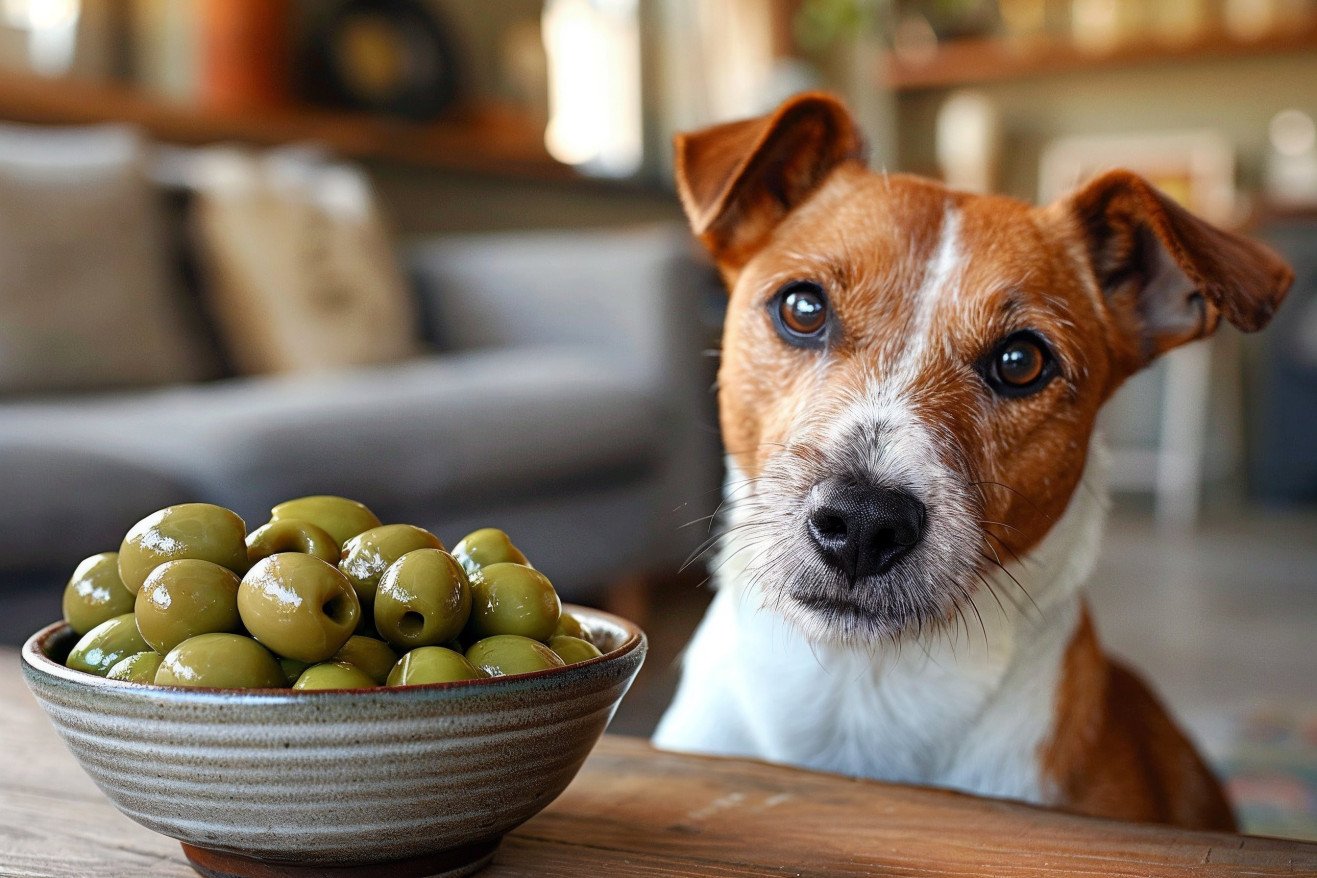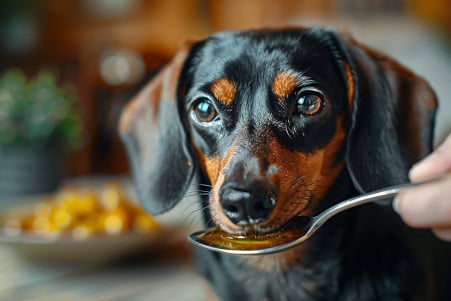Can Dogs Eat Olives? What to Know About the Risks and Benefits
9 March 2024 • Updated 9 March 2024

Olives are not toxic to dogs, so they can be given to dogs in moderation. However, olives need to be plain and pitted because the pits can be a choking hazard and the other ingredients can be dangerous.
If consumed in large amounts, especially for smaller dogs, the salt in olives can cause salt poisoning.
In this article, we will look at veterinary research and nutritional information to determine how olives impact a dog’s health. We will also look at how a dog’s digestive system processes the fats and sodium in olives, talk about the dietary needs of different breeds, and give you tips on how to introduce new foods to your dog.
By the end of this article, you will have all the information you need to decide if you want to give your dog this Mediterranean fruit.
Can dogs eat olives?
Exploring the Nutritional Value of Olives for Dogs
Olives are a nutritional powerhouse that can offer some health perks for dogs, as long as they are consumed in moderation. According to Texas Hill Country Olive Co., olives are low in calories and high in monounsaturated fats, which are important for healthy skin and coat in dogs.
They are also high in fiber, which can help with digestion and prevent constipation. The antioxidants in olives, including vitamin E and polyphenols, can help reduce inflammation and fight free radicals, which can help support a healthy immune system.
That said, there are some downsides to consider. The high sodium content in olives is a downside, especially for dogs with certain health conditions like high blood pressure and dogs that are prone to pancreatitis, which can be caused by the high fat content in olives. Texas Hill Country Olive Co. suggests that unsalted, pitted olives are the best option for dogs to avoid the potential dangers of pits and added seasonings.
It’s important to make sure that olives are being added to a dog’s diet in moderation to make sure that the nutritional benefits outweigh the potential downsides. It’s also important to make sure that a dog’s overall dietary needs are being met and that any treat, including olives, is part of a balanced diet.
Risks of Too Much Sodium and Fat in Your Dog’s Diet
While salt is an important electrolyte for dogs, too much of it can cause salt toxicity. PetMD explains that the signs of salt poisoning in dogs include vomiting, diarrhea, depression, and seizures, which can lead to more severe issues.
It’s important to make sure that your dog’s diet doesn’t have too much salt, especially since many commercial dog foods, including Hill’s Science Diet, already have the right amount of salt to make the food palatable and healthy.
Diets that are high in fat can also be problematic. A study published in PMC found that a high-fat diet can change the gut microbiota and fecal microbial population and activities in dogs.
Dogs process fats differently than people, and while the study by Monica Isabella Cutrignelli in PMC found that some fats can be good for dogs and provide a valuable energy source, it’s important to make sure that the right balance is maintained to avoid health problems like pancreatitis, which is a painful and potentially life-threatening inflammation of the pancreas.
If your dog shows any signs of illness after eating olives, including stomach upset, vomiting, or depression, make sure to contact your vet right away. To minimize the risk, only feed your dog olives in moderation and make sure they are pitted and don’t have added salt.
This is a good rule of thumb when it comes to feeding your dog any treats, and it’s also in keeping with the carnivorous nature of your dog’s digestive system, which is best suited to breaking down animal proteins.
How Dogs Process Plant-Based Foods
While dogs are not obligate carnivores, their digestive systems are designed to process animal-based foods more efficiently than plant-based foods. This is evidenced by their relatively short digestive tracts and a specific group of enzymes that are good at breaking down animal fats and proteins.
A study published in PMC by Daniel Mota-Rojas explains that while dogs can eat a plant-based diet, they don’t digest and absorb nutrients from plants as well as humans. Because of these digestive differences, dogs may not absorb or use the beneficial parts of olives, like vitamins and antioxidants, as effectively.
The American Kennel Club (AKC) notes that when you’re adding new foods like olives to your dog’s diet, you should introduce them slowly over a period of 5–7 days to avoid upsetting your dog’s stomach.
This slow introduction helps your dog’s digestive system adapt to the new food. Because olives are high in fat and sodium, it’s especially important to introduce them slowly, in small amounts, and in moderation.
Because of their digestive tendencies, olives can be a good occasional treat for dogs as long as they’re part of a balanced diet that meets most of your dog’s carnivorous needs.
Customizing Treats: Breed and Size Factors for Dogs and Olives
The wide variety of dog breeds also means a wide variety of dietary needs and metabolic processes. A study published in GeroScience even showed that there are metabolic differences between large and small dogs, especially in tryptophan metabolism.
This means that the size of a dog could impact how they metabolize certain foods, including olives. For example, a high-fat food like olives may be metabolized differently by a Chihuahua than a Great Dane, and the impact on the Chihuahua could be more severe.
The Clinical Nutrition Service at Cummings School also notes that one of the goals of therapeutic nutrition is to manage or prevent breed-specific health problems. For example, a Dalmatian that is prone to urinary stones will need a different diet than a sturdier breed like a Labrador. In the case of olives, the high fat and sodium content could be especially problematic for breeds that are prone to obesity or heart disease.
Dog owners will need to take their dog’s breed, size, and health history into account when feeding them olives.
For example, smaller breeds, which have a higher mass-specific metabolic rate according to a study published in PMC, may need to be given smaller amounts of olives to avoid consuming too much fat and sodium.
On the other hand, larger breeds may be able to tolerate slightly larger amounts of olives, but they should still be fed in moderation to avoid health problems. A veterinarian can offer personalized advice to make sure that treats like olives are a healthy addition to a dog’s diet.
So, Can Dogs Have Olives?
Based on the information above, olives can be a healthy treat for your dog if they are plain, pitted, and given in moderation. According to Pure Pet Food, while a few olives can offer health benefits like vitamin E, which is good for your dog’s skin and eyes, the size and salt content of olives can limit their positive effects, so it’s best to limit how many you give your dog.
According to Petco, while olives are not toxic to dogs, it’s important to make sure your dog doesn’t eat too many of them. This will help prevent salt poisoning and issues related to the pits, which can be especially dangerous for smaller dogs.
In general, experts agree that you should focus on your dog’s overall diet and health and work with your vet to determine how to incorporate new foods, including olives, into your dog’s diet. It’s also important to remember that treats like olives should never replace a healthy meal.
In the end, giving your dog treats is all about balance. If you know the risks and follow the recommended serving sizes, you can make sure that olives continue to be a fun and safe treat for your dog.


